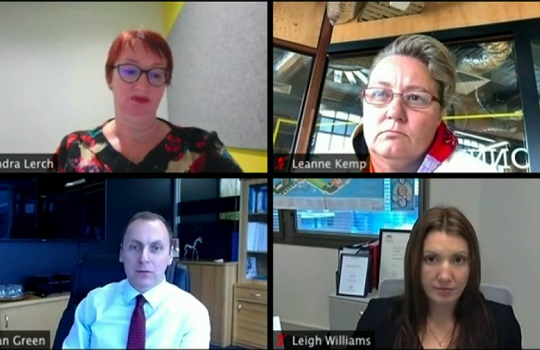
Technology has been instrumental for the public sector as it adjusts to life in the Covid-19 era. The pandemic has proved a catalyst for change and greater resilience within public agencies, forcing organisations to grow, adapt, and extend their citizen services offerings at an unprecedented pace.
In many cases, the pandemic has impelled agencies to re-evaluate and adopt new technology infrastructure and overcome operational hurdles, including greater employee mobilisation and remote working opportunities, that have long beset organisations.
These sentiments were shared during the 2020 FST Government Queensland virtual panel discussion, Positioning QLD for Success on the Road to Recovery Post-Covid-19: A Roadmap for Public Sector, which invited digital and innovation leaders from across the Sunshine State to explore digital opportunities found, and initiatives undertaken, during the coronavirus pandemic.
Sandra Lerch, acting executive director of workforce futures and inclusion at the Public Service Commission (PSC), acknowledged “a crisis can be useful sometimes”, particularly when it comes to driving change.
For Lerch, the Covid crisis saw an “acceleration in the pace of change” within her organisation.
Fellow panellists concurred, explaining that the Covid-19 pandemic has inspired a greater willingness to embrace change. In many cases, it has forced leaders to reflect and challenge both cultural and technological roadblocks within their organisations.
Leanne Kemp, founder and chief executive of Everledger and Queensland’s third chief entrepreneur, appeared to relish the opportunities that emerged for start-ups during the depths of the crisis.
She said entrepreneurs have been “presented with a very perfect storm for innovation to thrive and survive”.
It has also given upstart organisations invaluable opportunities to recognise “all the things [they] were not good at”, and better prepare their resources to bridge these shortfalls.
Adapting technology to continuously innovate
Rapid adoption of innovative technologies has proved critical to supporting agencies’ pandemic response, according to the panel. However, in many cases, by simply tweaking existing tech infrastructure, agencies could support major operational and process transformation goals, as well as adapt to the new working realities of the pandemic.
According to Lerch, by building a “new employee mobilisation service” on top of an existing enterprise management platform, the PSC was able to rapidly mobilise its workforce – in effect, allowing employees to shift “within and across agencies” to where they could be most productive.
This platform enabled staff to be deployed and undertake critical work in areas that best matched their unique skillsets, such as providing assistance to Queensland Health for contact tracing work.
“We had to quickly adapt to new technologies to enable collaboration, service delivery and teamwork in virtual environments.” – Sandra Lerch, Public Service Commission.
Panellists also recognised opportunities to “extend and scale” positive progress made during the pandemic.
Damian Green, chief executive officer at eHealth Queensland, emphasised the criticality of collaborative partnerships in fast-tracking transformation initiatives – ones that could materially extend the capability of public healthcare services.
“Digital has shown itself to be a great enabler to drive transformation, and it is best able to do that when we deliver technology innovation alongside our clinical and business partners to drive real outcomes.” – Damian Green, eHealth Queensland.
“Virtual care services”, “new apps to support screening at airports,” and “applications to support rapid check-in and contact tracing”, Green noted, all expedited during Covid, could now serve as integral functions of a post-Covid health services infrastructure.
After witnessing the success of virtual care services during the pandemic, eHealth Queensland is considering furthering the implementation of new “virtual care strategies” and telehealth services, enabling remote “at home” healthcare services for regional and rural communities.
Bridging the digital divide
When implementing new technology solutions, panellists agreed that digital solutions not only need to reflect the communities that use them, but that tangible efforts should be made to improve citizens’ digital literacy and, effectively, ‘democratise’ digital access.
Leigh Williams, executive director for customer engagement for Queensland’s Department of Education, emphasised the DoE’s focus on “literacy uplift for everyone across the state”, enabling the swift adoption of remote learning and preventing further disruptions to education.
Green echoed a similar sentiment, reiterating the need to place consumers at the heart of agencies’ digital strategies.
“A key action that we took right early on was embedding consumers at the peak of our leadership response,” Green said.
For instance, despite eHealth equipped in many areas to “go digital-first, Green acknowledged that the differing needs and skillsets of citizens must be catered for.
“We can’t leave anyone behind. We’ve got to make sure we are not creating a digital divide,” Green said.
Innovation from the top-down
The public sector needs to adopt digital innovation more readily, panellists agreed, emphasising the need for strong leadership to integrate new technologies within agencies.
Lerch urged for a more proactive approach when seeking appropriate “capability and technology uplift opportunities”.
Overall, panellists felt a top-down approach – one that prioritises decisive leadership – was the best way to advance digital innovation in the public sector.
Williams felt leaders should re-examine what a remote workforce ideally looks like and embrace innovation “as quickly as possible”.
Kemp shared a similar view, stressing that innovation should be “embedded within the leadership modelling across the entirety of government”.
Matt Maw, chief field technologist for Nutanix (ANZ), believes that while new innovations are critical, both government and commercial sectors must not neglect their existing digital resources at hand.
Maw acknowledged that significant headway in digital transformation initiatives can be achieved by converting or adapting existing technologies for agencies’ own unique needs.
The emergence of the post-Covid operating model
While digital transformation lies at the heart of successful operations post-Covid, agencies cannot ignore the importance of organisational cooperation, training, and collaboration, as well as the embrace of new flexible working models.
Lerch believes that up-skilling within organisations and maintaining a flexible approach is crucial for success, explaining that teams need to “innovate, iterate and be accepting of ambiguity” and, what is more, “learn on the fly”.
“In a post-Covid period, we can really broaden our focus to what it means to re-skill and up-skill the workforce to deliver new business models in a post-pandemic era.” – Sandra Lerch, Public Service Commission
Moreover, leaders, she said, should encourage greater role flexibility and empower employees to make decisions that work, ultimately, towards improving the citizen experience.
“Every employee, regardless of their responsibility, needs to be agile and to be able to implement new customer solutions as needed,” Lerch said.
eHealth’s Damien Green similarly urged agency heads to foster agile skills among their workers as well as forge strong relationships with clients, to ensure that, when a crisis hits, his staff are fully prepared and have the capability to respond.
He wants to start “building in the competencies to make sure [his] workforce has a ‘can do’ attitude”.
Ultimately, panellists were unanimous in their desire for increased workforce flexibility and sustainable change in order to move forward successfully.
In doing so, the public sector can enjoy a vast range of potential benefits such as improved collaboration and increased efficiency.
Maw believes that the pandemic has forced change upon the public sector, but stresses that change needed to be properly harnessed to ensure “long term sustainable growth”.
He warns agencies not to “lose the opportunity” that has been given to them.
Resist the urge to “overburden people with change,” he said. Instead, utilise changed agendas to “fast forward [the technical innovation] we all need”.





